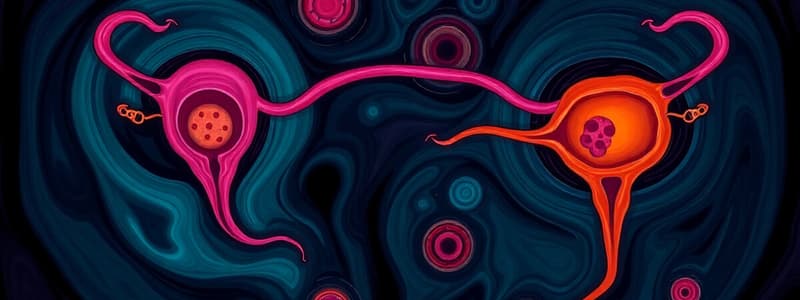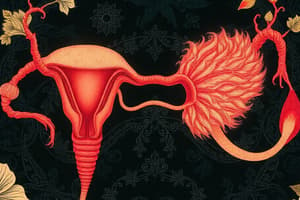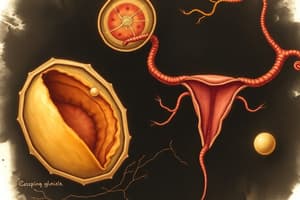Podcast
Questions and Answers
What is the primary function of gametes in the reproductive system?
What is the primary function of gametes in the reproductive system?
- Provide nutrients for the zygote
- Regulate body temperature
- Transmit genetic information to offspring (correct)
- Facilitate implantation in the uterus
- Stimulate hormone production
During fertilization, where does the fusion of sperm and oocyte typically occur?
During fertilization, where does the fusion of sperm and oocyte typically occur?
- Ampulla of the uterine tube (correct)
- Endometrium
- Cervix
- Isthmus of the uterine tube
- Vaginal canal
Which structure in the male reproductive system produces testosterone?
Which structure in the male reproductive system produces testosterone?
- Prostate gland
- Leydig cells (correct)
- Seminiferous tubules
- Sertoli cells
- Epididymis
What is the role of the Sertoli cells?
What is the role of the Sertoli cells?
What distinguishes meiosis I from meiosis II?
What distinguishes meiosis I from meiosis II?
Where does fertilization usually occur in the female reproductive tract?
Where does fertilization usually occur in the female reproductive tract?
What is the primary function of the corpus luteum?
What is the primary function of the corpus luteum?
Which hormone is primarily responsible for triggering ovulation?
Which hormone is primarily responsible for triggering ovulation?
What is the functional significance of the fimbriae?
What is the functional significance of the fimbriae?
What type of tissue composes the endometrium?
What type of tissue composes the endometrium?
What is the ploidy of a primary spermatocyte?
What is the ploidy of a primary spermatocyte?
Which process involves the differentiation of spermatids into mature sperm?
Which process involves the differentiation of spermatids into mature sperm?
At what stage does oogenesis arrest until puberty?
At what stage does oogenesis arrest until puberty?
What structure forms after the Graafian follicle releases its oocyte?
What structure forms after the Graafian follicle releases its oocyte?
Which hormone maintains the corpus luteum during early pregnancy?
Which hormone maintains the corpus luteum during early pregnancy?
During which stage of prenatal development do organ systems begin to develop?
During which stage of prenatal development do organ systems begin to develop?
Which layer of the embryo develops into the nervous system?
Which layer of the embryo develops into the nervous system?
What is the primary function of the placenta?
What is the primary function of the placenta?
Which event occurs first during fertilization?
Which event occurs first during fertilization?
How many chromosomes are present in a zygote?
How many chromosomes are present in a zygote?
Which hormone stimulates the anterior pituitary to release FSH and LH?
Which hormone stimulates the anterior pituitary to release FSH and LH?
What is the primary role of FSH in the female reproductive system?
What is the primary role of FSH in the female reproductive system?
Which hormone inhibits FSH secretion during the luteal phase?
Which hormone inhibits FSH secretion during the luteal phase?
What happens during the luteal phase of the ovarian cycle?
What happens during the luteal phase of the ovarian cycle?
Which hormone is critical for milk ejection during lactation?
Which hormone is critical for milk ejection during lactation?
Which muscle helps regulate the temperature of the testes?
Which muscle helps regulate the temperature of the testes?
What is the role of the epididymis?
What is the role of the epididymis?
Which structure connects the testes to the abdominal cavity?
Which structure connects the testes to the abdominal cavity?
What fluid does the prostate gland contribute to semen?
What fluid does the prostate gland contribute to semen?
Which part of the urethra runs through the penis?
Which part of the urethra runs through the penis?
Where does implantation typically occur?
Where does implantation typically occur?
Which uterine layer sheds during menstruation?
Which uterine layer sheds during menstruation?
What is the primary function of the uterine tubes?
What is the primary function of the uterine tubes?
What are the primary components of the mammary glands?
What are the primary components of the mammary glands?
What ligament supports the uterus in place?
What ligament supports the uterus in place?
What prevents polyspermy during fertilization?
What prevents polyspermy during fertilization?
At which stage does the zygote become a blastocyst?
At which stage does the zygote become a blastocyst?
What structure in the blastocyst becomes the embryo?
What structure in the blastocyst becomes the embryo?
Which term describes the hollow ball of cells formed after the morula?
Which term describes the hollow ball of cells formed after the morula?
What happens during gastrulation?
What happens during gastrulation?
What is the probability of two heterozygous parents producing a homozygous dominant offspring?
What is the probability of two heterozygous parents producing a homozygous dominant offspring?
Which type of inheritance involves a single trait determined by multiple genes?
Which type of inheritance involves a single trait determined by multiple genes?
Which genetic condition is associated with X-linked inheritance?
Which genetic condition is associated with X-linked inheritance?
What does a karyotype show?
What does a karyotype show?
Which type of allele requires two copies for its expression?
Which type of allele requires two copies for its expression?
What triggers the release of oxytocin during labor?
What triggers the release of oxytocin during labor?
What is the role of prolactin during lactation?
What is the role of prolactin during lactation?
What is the significance of the Apgar score?
What is the significance of the Apgar score?
Which hormone is highest during the first trimester of pregnancy?
Which hormone is highest during the first trimester of pregnancy?
What is the function of the umbilical cord?
What is the function of the umbilical cord?
What structure forms from the trophoblast and aids in implantation?
What structure forms from the trophoblast and aids in implantation?
What hormone is secreted by the placenta to maintain the endometrial lining?
What hormone is secreted by the placenta to maintain the endometrial lining?
What occurs during the fetal period of development?
What occurs during the fetal period of development?
What is the function of the amniotic fluid?
What is the function of the amniotic fluid?
Which hormone increases uterine excitability at the onset of labor?
Which hormone increases uterine excitability at the onset of labor?
What is the first stage of labor?
What is the first stage of labor?
What is assessed by the "Grimace" component of the Apgar score?
What is assessed by the "Grimace" component of the Apgar score?
Which fetal structure closes to separate the pulmonary and systemic circulation after birth?
Which fetal structure closes to separate the pulmonary and systemic circulation after birth?
What is the primary role of lanugo on a developing fetus?
What is the primary role of lanugo on a developing fetus?
What initiates the production of meconium in a newborn?
What initiates the production of meconium in a newborn?
Which type of inheritance results in a blended phenotype?
Which type of inheritance results in a blended phenotype?
What is the genotype for a heterozygous individual with a dominant and recessive allele?
What is the genotype for a heterozygous individual with a dominant and recessive allele?
What is the probability of a male inheriting an X-linked trait from a carrier mother?
What is the probability of a male inheriting an X-linked trait from a carrier mother?
What determines the sex of a human embryo?
What determines the sex of a human embryo?
What does codominance mean in genetics?
What does codominance mean in genetics?
What is a common physical change in males due to aging?
What is a common physical change in males due to aging?
What happens to the uterine size after menopause?
What happens to the uterine size after menopause?
What causes hot flashes during menopause?
What causes hot flashes during menopause?
Which tissue is affected most by reduced elasticity in aging?
Which tissue is affected most by reduced elasticity in aging?
What is a significant risk factor for developing osteoporosis in aging women?
What is a significant risk factor for developing osteoporosis in aging women?
Flashcards
Gamete function
Gamete function
Transmit genetic information to offspring.
Fertilization site
Fertilization site
Typically occurs in the ampulla of the uterine tube.
Testosterone producer
Testosterone producer
Leydig cells produce testosterone in males.
Sertoli cells' role
Sertoli cells' role
Signup and view all the flashcards
Meiosis I vs. Meiosis II
Meiosis I vs. Meiosis II
Signup and view all the flashcards
Female fertilization site
Female fertilization site
Signup and view all the flashcards
Corpus luteum function
Corpus luteum function
Signup and view all the flashcards
Ovulation trigger
Ovulation trigger
Signup and view all the flashcards
Fimbriae function
Fimbriae function
Signup and view all the flashcards
Endometrium tissue
Endometrium tissue
Signup and view all the flashcards
Primary spermatocyte ploidy
Primary spermatocyte ploidy
Signup and view all the flashcards
Spermatid differentiation
Spermatid differentiation
Signup and view all the flashcards
Oogenesis arrest stage
Oogenesis arrest stage
Signup and view all the flashcards
Post-ovulation follicle structure
Post-ovulation follicle structure
Signup and view all the flashcards
hCG function during pregnancy
hCG function during pregnancy
Signup and view all the flashcards
Prenatal organ development stage
Prenatal organ development stage
Signup and view all the flashcards
Nervous system precursor layer
Nervous system precursor layer
Signup and view all the flashcards
Placenta function
Placenta function
Signup and view all the flashcards
First fertilization event
First fertilization event
Signup and view all the flashcards
Zygote chromosome count
Zygote chromosome count
Signup and view all the flashcards
GnRH function
GnRH function
Signup and view all the flashcards
FSH's primary female role
FSH's primary female role
Signup and view all the flashcards
Luteal phase inhibitor
Luteal phase inhibitor
Signup and view all the flashcards
Luteal phase event
Luteal phase event
Signup and view all the flashcards
Milk ejection hormone
Milk ejection hormone
Signup and view all the flashcards
Testes temperature regulator
Testes temperature regulator
Signup and view all the flashcards
Epididymis role
Epididymis role
Signup and view all the flashcards
Testes to abdomen connection
Testes to abdomen connection
Signup and view all the flashcards
Prostate fluid
Prostate fluid
Signup and view all the flashcards
Penile urethra part
Penile urethra part
Signup and view all the flashcards
Implantation site
Implantation site
Signup and view all the flashcards
Menstrual layer
Menstrual layer
Signup and view all the flashcards
Uterine tube function
Uterine tube function
Signup and view all the flashcards
Mammary gland components
Mammary gland components
Signup and view all the flashcards
Uterus support ligament
Uterus support ligament
Signup and view all the flashcards
Polyspermy prevention
Polyspermy prevention
Signup and view all the flashcards
Zygote to blastocyst stage
Zygote to blastocyst stage
Signup and view all the flashcards
Embryo formation from blastocyst
Embryo formation from blastocyst
Signup and view all the flashcards
Blastocyst description
Blastocyst description
Signup and view all the flashcards
Gastrulation outcome
Gastrulation outcome
Signup and view all the flashcards
Homozygous dominant offspring probability
Homozygous dominant offspring probability
Signup and view all the flashcards
Multiple-gene inheritance type
Multiple-gene inheritance type
Signup and view all the flashcards
X-linked inheritance example
X-linked inheritance example
Signup and view all the flashcards
Karyotype shows
Karyotype shows
Signup and view all the flashcards
Recessive allele expression
Recessive allele expression
Signup and view all the flashcards
Labor oxytocin trigger
Labor oxytocin trigger
Signup and view all the flashcards
Lactation hormone for milk production
Lactation hormone for milk production
Signup and view all the flashcards
Apgar score use
Apgar score use
Signup and view all the flashcards
Highest pregnancy hormone (first trimester)
Highest pregnancy hormone (first trimester)
Signup and view all the flashcards
Umbilical cord function
Umbilical cord function
Signup and view all the flashcards
Endometrium-sustaining hormone
Endometrium-sustaining hormone
Signup and view all the flashcards
Fetal period
Fetal period
Signup and view all the flashcards
Amniotic fluid role
Amniotic fluid role
Signup and view all the flashcards
Labor initiation hormone
Labor initiation hormone
Signup and view all the flashcards
First labor stage
First labor stage
Signup and view all the flashcards
Apgar 'Grimace'
Apgar 'Grimace'
Signup and view all the flashcards
Post-birth circulatory change
Post-birth circulatory change
Signup and view all the flashcards
Lanugo function
Lanugo function
Signup and view all the flashcards
Meconium production
Meconium production
Signup and view all the flashcards
Blended phenotype inheritance
Blended phenotype inheritance
Signup and view all the flashcards
Heterozygous genotype
Heterozygous genotype
Signup and view all the flashcards
X-linked trait inheritance probability
X-linked trait inheritance probability
Signup and view all the flashcards
Sex determination
Sex determination
Signup and view all the flashcards
Codominance in genetics
Codominance in genetics
Signup and view all the flashcards
Male aging change
Male aging change
Signup and view all the flashcards
Menopause and uterus size
Menopause and uterus size
Signup and view all the flashcards
Menopausal hot flashes
Menopausal hot flashes
Signup and view all the flashcards
Elasticity loss in aging
Elasticity loss in aging
Signup and view all the flashcards
Osteoporosis risk factor
Osteoporosis risk factor
Signup and view all the flashcards
Inner cell mass function
Inner cell mass function
Signup and view all the flashcards
Trophoblast function
Trophoblast function
Signup and view all the flashcards
Germ layer formation
Germ layer formation
Signup and view all the flashcards
Amnion function
Amnion function
Signup and view all the flashcards
Chorion function
Chorion function
Signup and view all the flashcards
Placental hormone function
Placental hormone function
Signup and view all the flashcards
Fetal circulation change
Fetal circulation change
Signup and view all the flashcards
Uterine involution
Uterine involution
Signup and view all the flashcards
Oxytocin function
Oxytocin function
Signup and view all the flashcards
Apgar score components
Apgar score components
Signup and view all the flashcards
Study Notes
Reproductive System
- Gamete function: Transmit genetic information to offspring.
- Fertilization site: Typically occurs in the ampulla of the uterine tube.
- Testosterone production: Leydig cells in the male reproductive system produce testosterone.
- Sertoli cell role: Nourish and protect developing sperm.
- Meiosis I vs. Meiosis II: Meiosis I separates homologous chromosomes; Meiosis II separates sister chromatids.
Female Reproductive System
- Fertilization location: Ampulla of the uterine tube.
- Corpus luteum function: Produces estrogen and progesterone after ovulation.
- Ovulation trigger: Luteinizing hormone (LH).
- Fimbriae function: Sweep the oocyte into the uterine tube.
- Endometrium composition: Simple columnar epithelium with tubular glands.
Spermatogenesis and Oogenesis
- Primary spermatocyte ploidy: Diploid.
- Spermatid maturation: Spermiogenesis differentiates spermatids into mature sperm.
- Oogenesis arrest: Arrests in prophase I until puberty.
- Post-ovulation structure: Corpus luteum forms after the Graafian follicle releases its oocyte.
- Corpus luteum maintenance: Human chorionic gonadotropin (hCG) maintains the corpus luteum during early pregnancy.
Development and Genetics
- Organ system development: Embryonic period.
- Nervous system development source: Ectoderm.
- Placenta function: Provides oxygen and nutrients to the fetus.
- Fertilization initiation: Penetration of the corona radiata by the sperm.
- Zygote chromosome count: 46 chromosomes.
Hormonal Control of Reproduction
- FSH and LH release trigger: Gonadotropin-releasing hormone (GnRH).
- FSH's female role: Stimulates follicular development.
- Luteal phase inhibitor: Inhibin.
- Luteal phase event: Corpus luteum forms and secretes hormones.
- Milk ejection hormone: Oxytocin.
Male Reproductive Anatomy
- Testis temperature regulation: Dartos muscle.
- Epididymis role: Stores and matures sperm.
- Testes to abdomen connection: Vas deferens.
- Prostate gland secretion: Slightly acidic fluid with enzymes like PSA.
- Penile urethra: Spongy (penile) urethra.
Female Reproductive Anatomy
- Implantation location: Endometrium of the uterus.
- Menstruation shedding layer: Endometrial functional layer.
- Uterine tube function: Transport oocytes to the uterus.
- Mammary gland components: Lobules, alveoli, and lactiferous ducts.
- Uterine support: Round ligament.
Fertilization and Early Development
- Polyspermy prevention: Cortical reaction and zona pellucida changes.
- Blastocyst formation: Day 5.
- Embryo origin in blastocyst: Inner cell mass.
- Blastocyst structure: Hollow ball of cells.
- Gastrulation process: Formation of the primitive streak and three germ layers.
Genetics
- Heterozygous parent probability: 25% chance of producing a homozygous dominant offspring.
- Multiple gene trait: Polygenic inheritance.
- X-linked condition example: Hemophilia A.
- Karyotype reveals: Chromosomal abnormalities and structure.
- Recessive allele expression: Requires two copies.
Pregnancy and Lactation
- Labor oxytocin trigger: Stretching of the uterus.
- Milk production hormone: Prolactin.
- Newborn health assessment: Apgar score.
- First trimester hormone: hCG.
- Umbilical cord function: Provide oxygen and nutrients to the fetus.
Studying That Suits You
Use AI to generate personalized quizzes and flashcards to suit your learning preferences.




